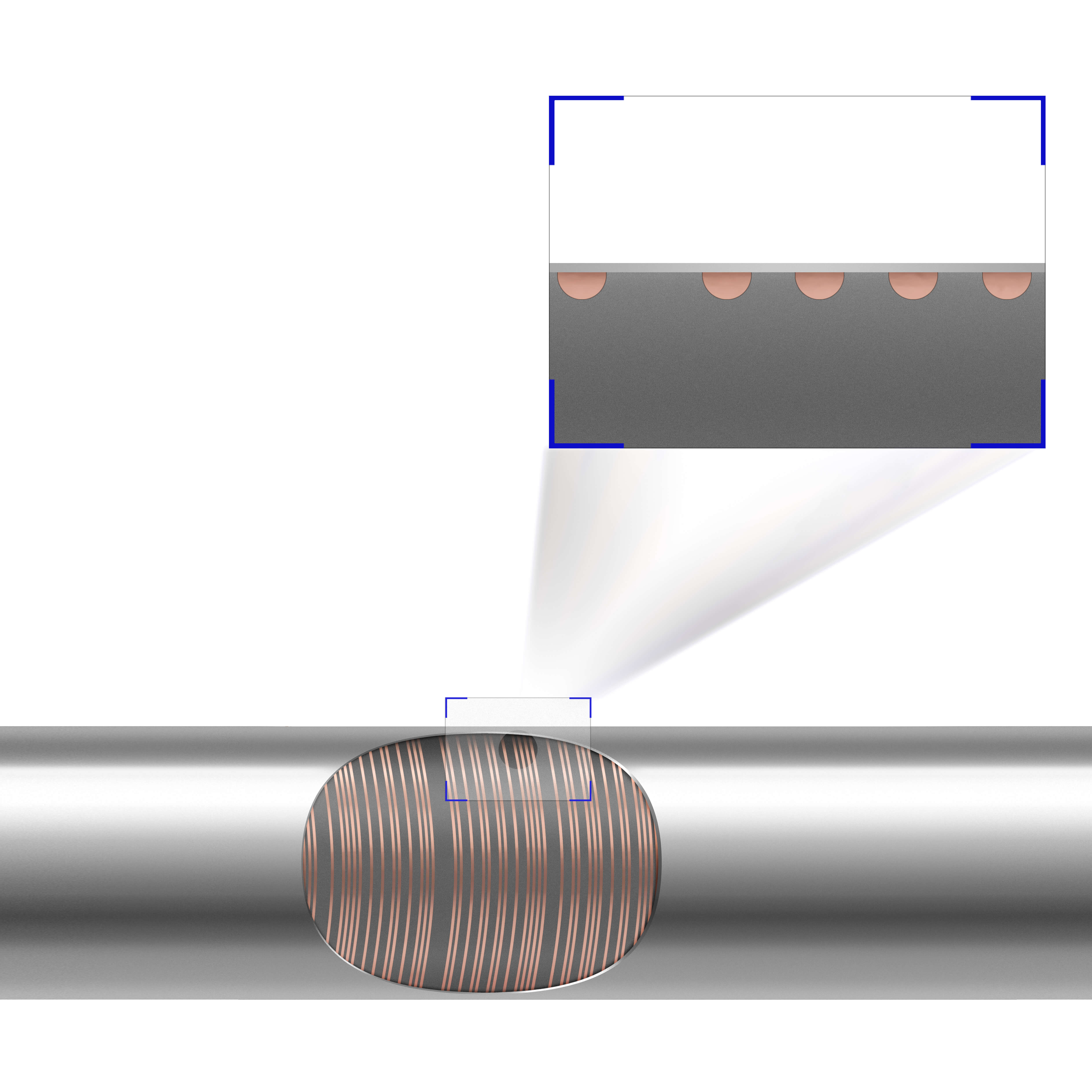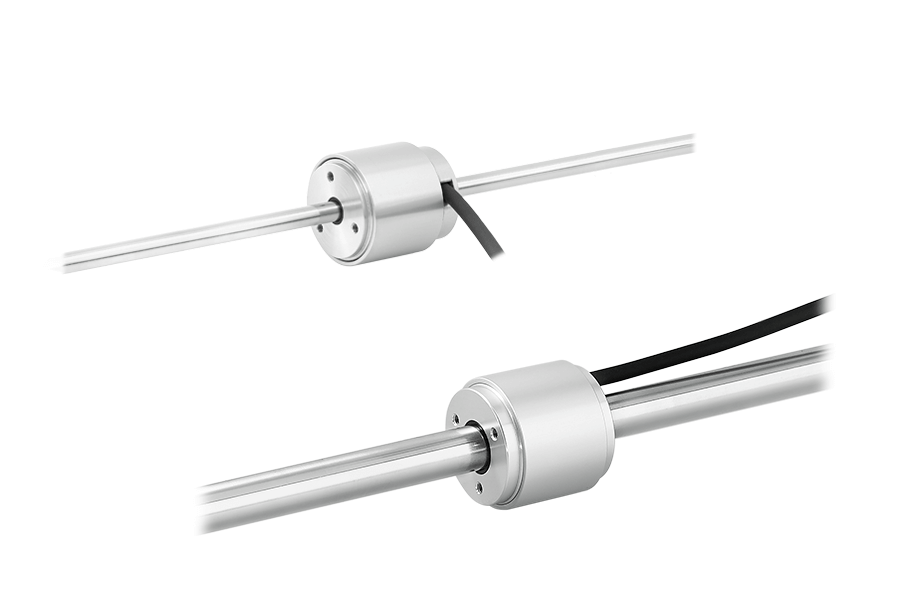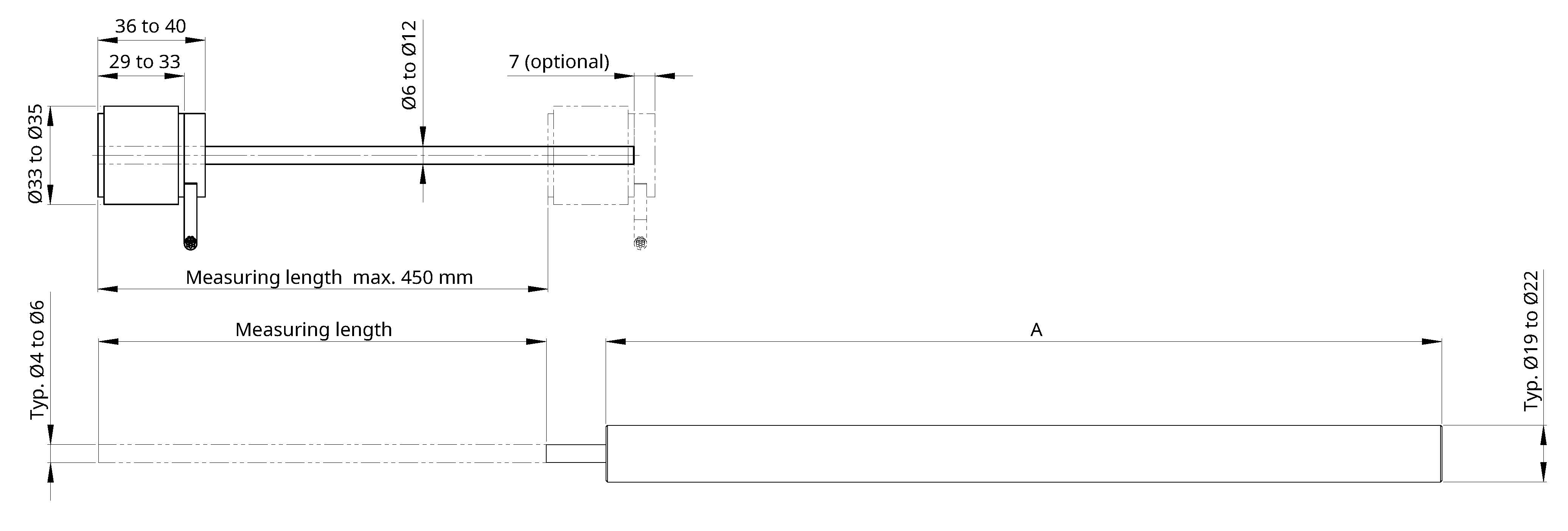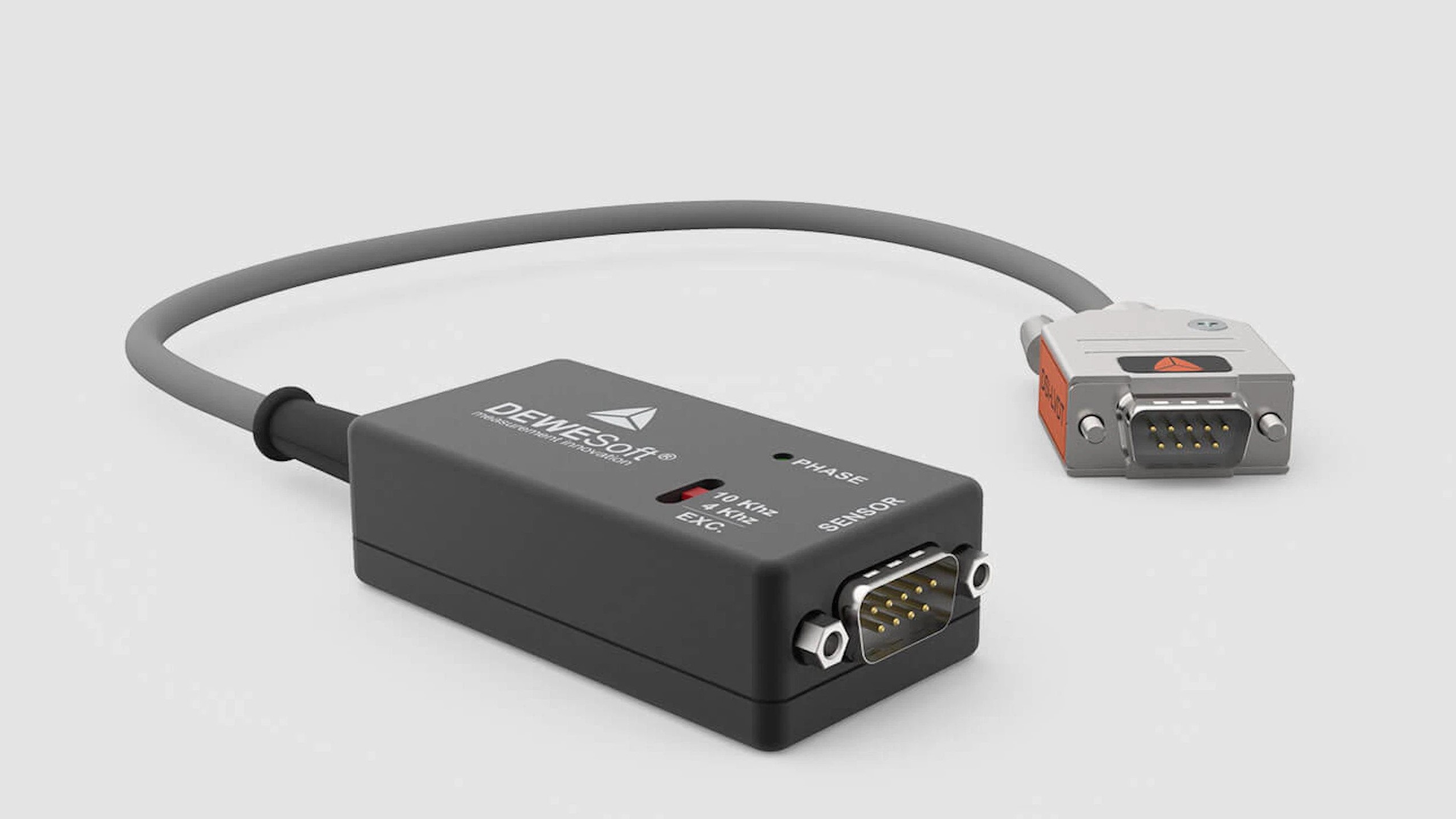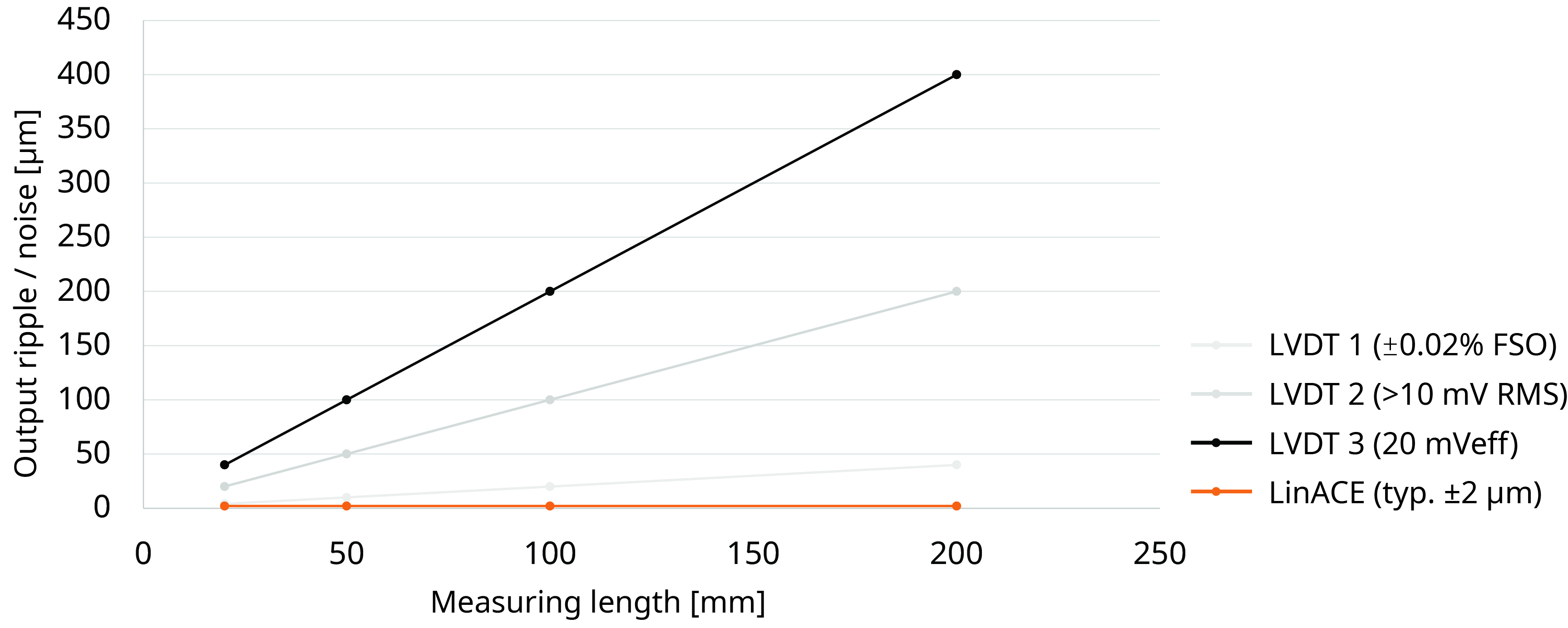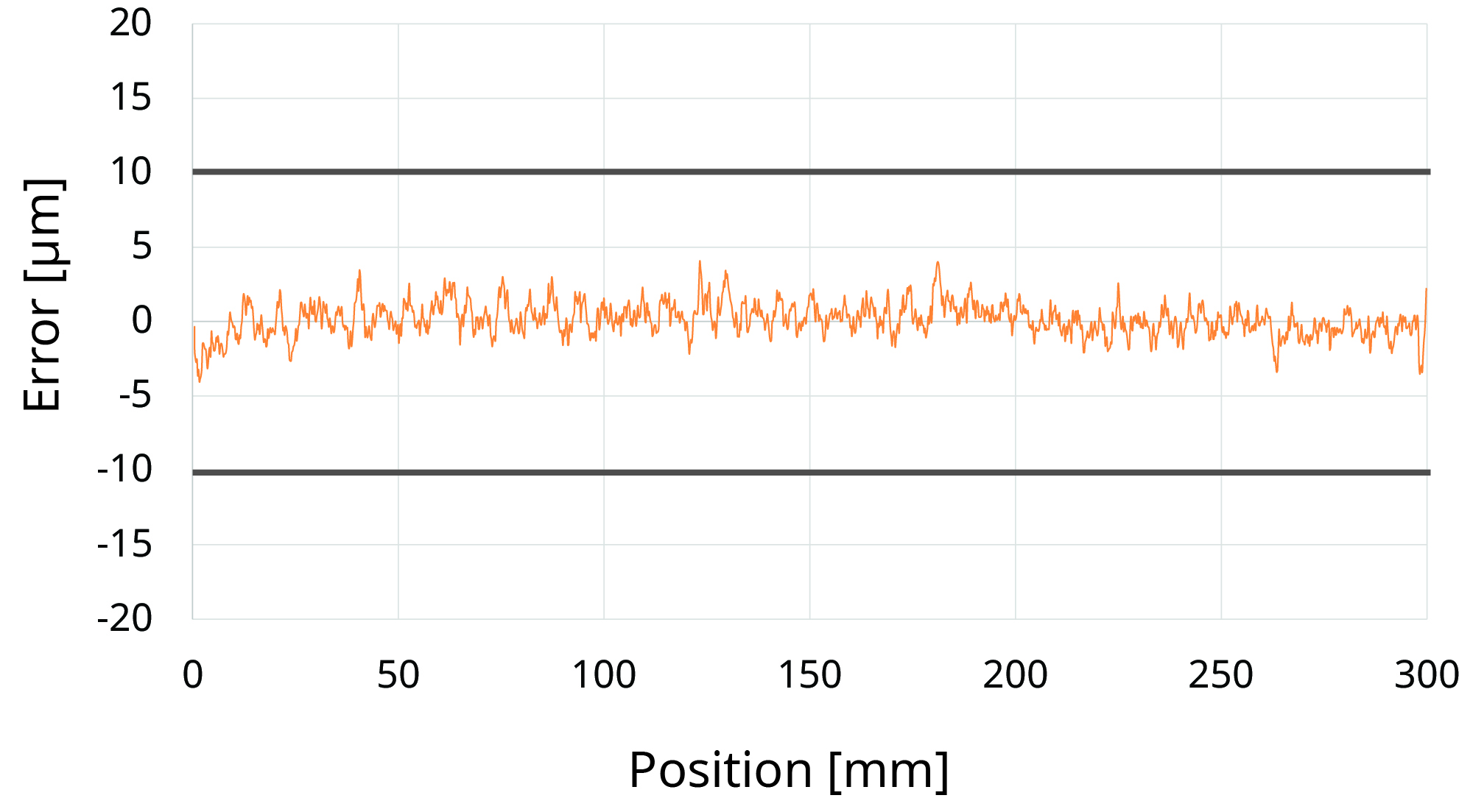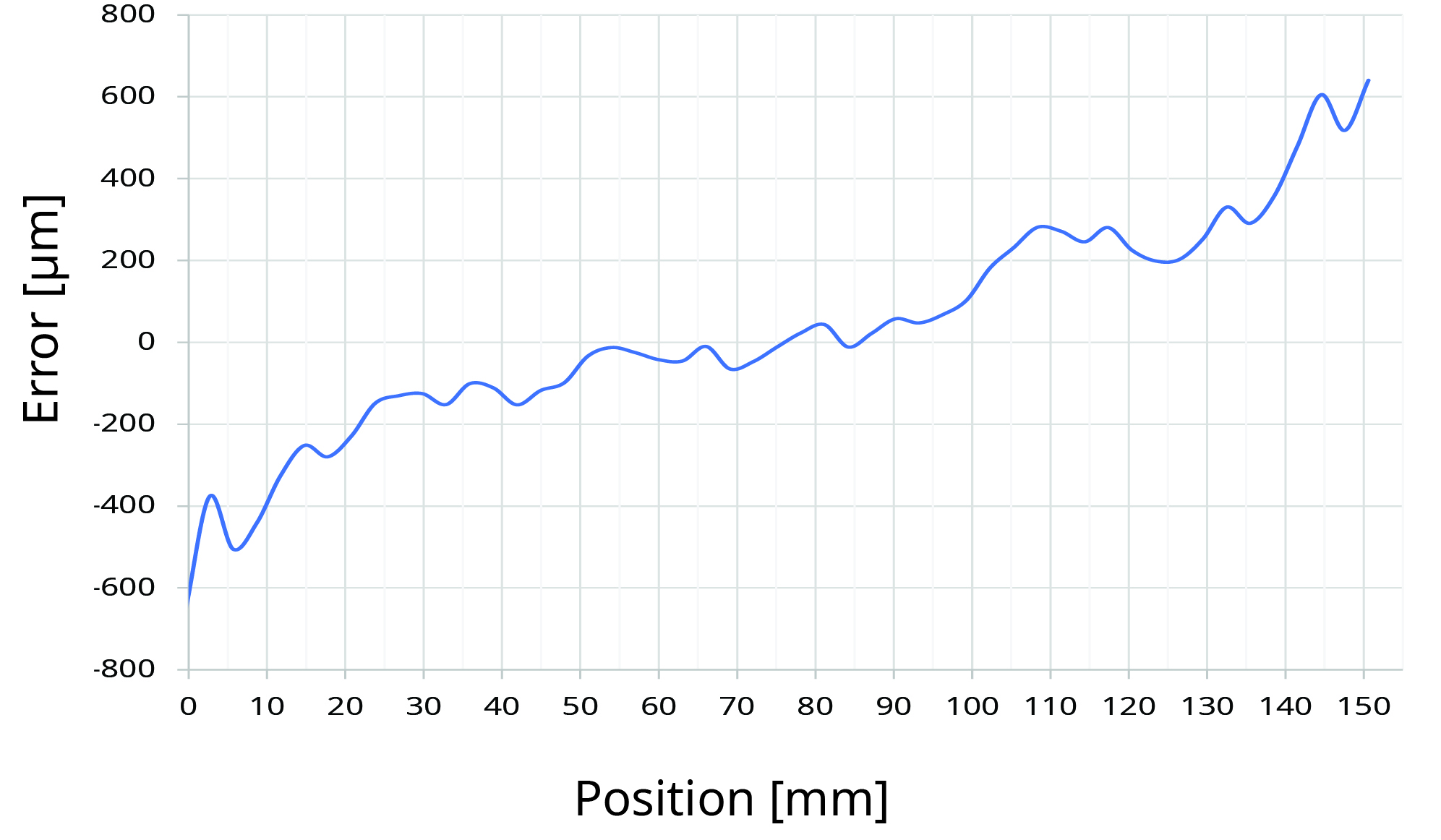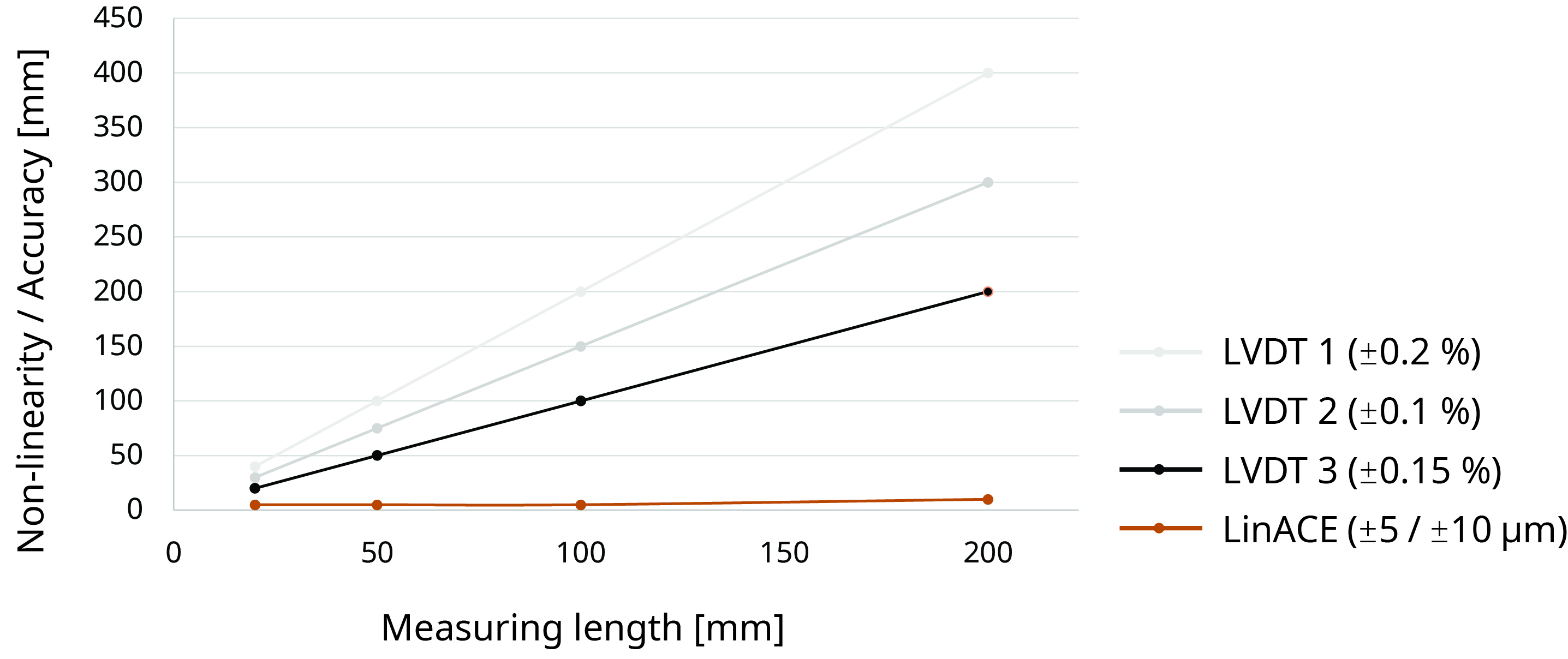LinACE™ with digital outputs vs. LVDT sensor
LinACE™ は、物体の直線状の動きを電気信号に変換する電気機械センサーです。
デジタル信号には、電磁干渉に強い、自己モニタリングを組込みできる、CRC などのエラー検出コードを実装できる、といったアナログ信号に対してのメリットがあります。特にケーブルが長い場合に、高い信頼性を発揮しやすくなります。
LVDT (線形可変差動変圧器) は、チューブの周囲に配置された 3 個のコイルから構成されることがほとんどで、中央のコイルがメインコイルとして、残りの 2 個が補助コイルとして機能します。そして、強磁性体のコアが軸に沿ってスライドします。
コアが動くと、メインコイルと補助コイル間の磁気連結が変化し、誘導電圧も変化します。そして、補助コイルの誘導電圧同士の差が位置情報に変換されます。
コンパクト設計
LVDT とは異なり、LinACE リードヘッドの長さは、測定長がいくつであっても変わりません。LinACE リードヘッドは長さ 29mm~40mm、最大直径 35mm で、
LVDT では測定長よりも長いコイルが必要になります。そのためセンサーヘッドが測定長に応じて長くなります。
測定長 20mm 以上の LVDT は直径が 19mm または 22mm あることが一般的で、処理用のエレクトロニクスを内部または外部に搭載します。エレクトロニクスを内蔵する場合はセンサーヘッドがさらに長くなり、外部に搭載した場合には、以下のようなマイナス要素が見られます。
- 配線の追加
- 取付けスペースの増大
- コスト増
LinACE v.s. LVDT: リードヘッドの長さと質量
| 測定長 [mm] | 長さ (mm) | 質量 (g) | ||
| LinACE | LVDT (A) | LinACE | LVDT | |
| 20 | 29 | 140 | 94 | 130 |
| 100 | 29 | 230 | 111 | 265 |
| 150 | 29 | 280 | 122 | 325 |
| 300 | 29 | 450 | 144 | 520 |
- LVDT: 推定した典型値 (エレクトロニクス内蔵)。
- LinACE: 軸方向ケーブル引出し、ケーブル長 1m、シャフト直径 6mm。
デジタル出力、安定した測定と信頼性
LinACE の対応出力形式は、PWM、SSI および BiSS で、選択可能な分解能の範囲は 10µm~0.5µm、最高速度は 5m/s です。
高性能な自己診断機能が内蔵されており、複数の内部パラメータが常時チェックされます。エラー、警告などのステータス信号は、すべてのプロトコルで確認できます。シグナルコンディショナなど追加エレクトロニクスは不要です。
通常、LVDT はアナログ出力のみで、ステータス情報を出力することもできません。処理用のエレクトロニクス (またはシグナルコンディショナ) を別途設ける必要があります。
LVDT 用シグナルコンディショナの例。DEWESoft 製 DSI-LVDT アダプタ:"
熱安定性
温度が変化すると、位置ずれが生じることが予想されます。LVDT の典型的な熱膨張係数は 0.015%/K~0.04%/K で、大きな温度ドリフトが見られます。特に測定長が長くなると顕著です。
温度が変化しても、LinACE の測定位置は、スチールシャフトとリードヘッドのアルミハウジングの熱膨張以外の影響を受けません。通常、機器のフレームの熱膨張範囲内に収まります。
リップル - 信号のノイズ
LVDT のリップルまたは信号のノイズは通常、mV (RMS) または mV (eff) で表されます。測定長が長くなるほど、精度に大きな影響が出ます。一般に、リップル (ノイズ) は測定範囲の中央で低く、端部で高くなります。測定長が 150mm の場合、ノイズレベルは 30µm~300µm となり、ハイエンドな LVDT であれば、測定範囲の中央で 3µm 程度となる可能性があります。
LinACE の場合、ノイズレベルは測定長がいくつであっても変わりません。通常、2µm 未満です。
信号ノイズと測定長の関係
20mm 以上での測定精度
LinACE は、分解能 10µm~0.5µm、精度 ±100µm~±5µm でご用意しております。精度 ±5µm であれば、最大測定長は 100mm で、精度 ±10µm であれば 450mm です。以下のグラフに、測定長 300mm の LinACE の平均精度と、精度 ±10µm を記載します。
ただし、シャフトとアルミハウジングの熱膨張に起因する温度ドリフトを考慮する必要があります。
LVDT の典型的な非リニアリティは 0.1%~0.5%のため、精度と分解能は、測定長が 10mm 以下であれば優れます (非リニアリティ 0.1%の場合、±5mm の移動量で ±5µm)。しかしながら移動量が 100mm になると、非直線性の誤差が 100µm 以上になることが予想されます。リニアリティを改善するために、ユーザー側でキャリブレーションを追加で行うことが求められます。
以下の LinACE と LVDT の精度比較グラフでは、非リニアリティが 0.1%、0.15% および 0.2% の LVDT を記載しております。ご覧のとおり、測定長が長くなるほど LinACE のほうが精度の点で優位になります。
LinACE と LVDT の精度比較グラフ
変位センサー特有のプリ/ポストトラベル誤差がない
LinACE にはプリ/ポストトラベルがありません。シャフトの端から端までのストロークを無駄なく使用できます。
LVDT の出力は、コアの動きの仕様範囲においては非常に直線的ですが、範囲外ではリニアリティが低下します。その範囲は一般的に数 mm 以内です。
- プリトラベル: LVDT の最も外側の位置 (可動部が機械的なストッパにあたる位置) から LVDT 測定範囲の始点までの機械的な動き。
- ポストトラベル: LVDT の測定範囲 (内側) の終点から可動部が機械的なストッパにあたる最も内側の位置までの機械的な動き。
仕様の比較
| LinACE | LVDT | |
| 測定長 | 20mm~450mm | 0.254mm~700mm |
| エンコーダ長 | 測定長 + 29mm~40mm | 測定長のおよそ 2 倍 |
| 分解能 | 最高 0.5µm (20mm で >15bit) | <15bit |
| 精度 | 最高 ±5µm | |
| 非リニアリティ | 0~100mm で <0.01% | 0.1 / 0.2 / 0.25 / 0.5 (%) |
| 繰り返し精度 | 1 µm | 0.01%~0.1% (0~100mm で 10µm~100µm) |
| 出力帯域幅 | 2000 Hz | 15Hz~500Hz |
| 出力 | 非同期シリアル、PWM、SSI、BiSS | アナログ、RS485 |
| 供給電圧 | 5 V | 5V~12V または 10V~30V |
| 消費電力 |
平均 500mW* 最大 600mW* |
300mW~700mW |
| IP 保護 | IP40 | IP40~IP68 |
| 温度 | -30°C~+105°C |
0°C~+65°C または -40°C~+200°C |
*無出力負荷時。



